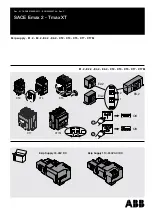
6
1
2
3
C
A
3
B
The apparatus must not be handled by putting lifting
devices directly under the apparatus itself. Should it be
necessary to use this technique, put the circuit-breaker
onto a pallet or a sturdy supporting surface (see fig. 3).
In any case, it is always advisable to carry out lifting
using the supports (3).
Version
Pole centre distance
Rated current
Hole
Fixed
150-210 mm
up to 1250 A
A
Fixed
275 mm
from 1600 to 3150 A
A
Fixed
210 mm
from 1600 to 2000
A
Withdrawable
150 mm
up to 1250 A
A
Withdrawable
210 mm
from 1600 to 2500 A
B
Withdrawable
275 mm
up to 1250 A
B
Withdrawable
275 mm
from 1600 to 3150 A
C
Withdrawable
210 mm
up to 1250 A
C
Fig. 2
Fig. 3
Fig. 1
Caption
A Circuit-breaker rating plate.
B Operating mechanism rating plate.
1 Type of apparatus.
2 Symbols of compliance with Standards.
3 Serial number.
4 Circuit-breaker characteristics.
5 Characteristics of the operating mechanism auxiliaries.
4. Handling
Before carrying out any operations, always make sure that the
operating mechanism spring is discharged and that the apparatus is
in the open position.
To lift and handle the circuit-breaker, proceed as follows (fig. 2):
– use a special lifting tool (1) (not supplied) fitted with ropes with
safety hooks (2);
– insert the hooks (2) in the supports (3) fixed to the frame of the
circuit-breaker and lift. Put the hooks (2) into the support holes (3)
according to the type of apparatus (see table);
– on completion of the operation (and in any case before putting into
service) unhook the lifting tool (1) and dismantle the supports (3)
from the frame.
During handling, take great care not to stress the insulating parts and
the terminals of the circuit-breaker.
A
B
3
4
2
1
5
CIRCUIT-BREAKER
IEC 62271-100
VD4 ... ... ...
CEI 17-1
CLASSIFICATION ... ... ...
SN ... ... ...
PR. YEAR ......
M
MASS
... kV
Ur
ELECTRIC DIAGRAM ... ... ... ...
FIG. ... ...
.. ... ... ...
OPERATING MECHANISM
-MO1 ... ... ... V
Made by ABB
































